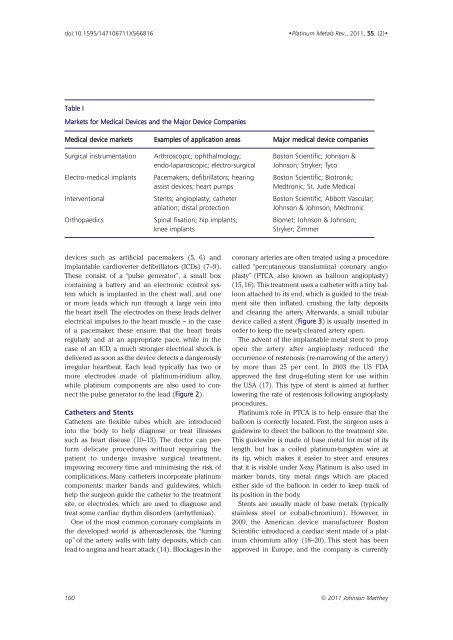Download - Platinum Metals Review
Download - Platinum Metals Review
Download - Platinum Metals Review
You also want an ePaper? Increase the reach of your titles
YUMPU automatically turns print PDFs into web optimized ePapers that Google loves.
doi:10.1595/147106711X566816<br />
•<strong>Platinum</strong> <strong>Metals</strong> Rev., 2011, 55, (2)•<br />
Table I<br />
Markets for Medical Devices and the Major Device Companies<br />
Medical device markets Examples of application areas Major medical device companies<br />
Surgical instrumentation Arthroscopic; ophthalmology; Boston Scientific; Johnson &<br />
endo-laparoscopic; electro-surgical Johnson; Stryker; Tyco<br />
Electro-medical implants Pacemakers; defibrillators; hearing Boston Scientific; Biotronik;<br />
assist devices; heart pumps<br />
Medtronic; St. Jude Medical<br />
Interventional Stents; angioplasty; catheter Boston Scientific; Abbott Vascular;<br />
ablation; distal protection<br />
Johnson & Johnson; Medtronic<br />
Orthopaedics Spinal fixation; hip implants; Biomet; Johnson & Johnson;<br />
knee implants<br />
Stryker; Zimmer<br />
devices such as artificial pacemakers (5, 6) and<br />
implantable cardioverter defibrillators (ICDs) (7–9).<br />
These consist of a “pulse generator”, a small box<br />
containing a battery and an electronic control system<br />
which is implanted in the chest wall, and one<br />
or more leads which run through a large vein into<br />
the heart itself. The electrodes on these leads deliver<br />
electrical impulses to the heart muscle – in the case<br />
of a pacemaker, these ensure that the heart beats<br />
regularly and at an appropriate pace, while in the<br />
case of an ICD, a much stronger electrical shock is<br />
delivered as soon as the device detects a dangerously<br />
irregular heartbeat. Each lead typically has two or<br />
more electrodes made of platinum-iridium alloy,<br />
while platinum components are also used to connect<br />
the pulse generator to the lead (Figure 2).<br />
Catheters and Stents<br />
Catheters are flexible tubes which are introduced<br />
into the body to help diagnose or treat illnesses<br />
such as heart disease (10–13). The doctor can perform<br />
delicate procedures without requiring the<br />
patient to undergo invasive surgical treatment,<br />
improving recovery time and minimising the risk of<br />
complications. Many catheters incorporate platinum<br />
components: marker bands and guidewires, which<br />
help the surgeon guide the catheter to the treatment<br />
site, or electrodes, which are used to diagnose and<br />
treat some cardiac rhythm disorders (arrhythmias).<br />
One of the most common coronary complaints in<br />
the developed world is atherosclerosis, the “furring<br />
up” of the artery walls with fatty deposits, which can<br />
lead to angina and heart attack (14). Blockages in the<br />
coronary arteries are often treated using a procedure<br />
called “percutaneous transluminal coronary angioplasty”<br />
(PTCA, also known as balloon angioplasty)<br />
(15, 16). This treatment uses a catheter with a tiny balloon<br />
attached to its end, which is guided to the treatment<br />
site then inflated, crushing the fatty deposits<br />
and clearing the artery. Afterwards, a small tubular<br />
device called a stent (Figure 3) is usually inserted in<br />
order to keep the newly-cleared artery open.<br />
The advent of the implantable metal stent to prop<br />
open the artery after angioplasty reduced the<br />
occurrence of restenosis (re-narrowing of the artery)<br />
by more than 25 per cent. In 2003 the US FDA<br />
approved the first drug-eluting stent for use within<br />
the USA (17). This type of stent is aimed at further<br />
lowering the rate of restenosis following angioplasty<br />
procedures.<br />
<strong>Platinum</strong>’s role in PTCA is to help ensure that the<br />
balloon is correctly located. First, the surgeon uses a<br />
guidewire to direct the balloon to the treatment site.<br />
This guidewire is made of base metal for most of its<br />
length, but has a coiled platinum-tungsten wire at<br />
its tip, which makes it easier to steer and ensures<br />
that it is visible under X-ray. <strong>Platinum</strong> is also used in<br />
marker bands, tiny metal rings which are placed<br />
either side of the balloon in order to keep track of<br />
its position in the body.<br />
Stents are usually made of base metals (typically<br />
stainless steel or cobalt-chromium). However, in<br />
2009, the American device manufacturer Boston<br />
Scientific introduced a cardiac stent made of a platinum<br />
chromium alloy (18–20). This stent has been<br />
approved in Europe, and the company is currently<br />
100 © 2011 Johnson Matthey
















